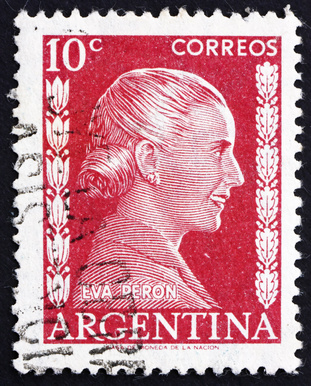Eva Perón was born María Eva Duarte in 1919 in a small village in Argentina. Her early life was difficult because her mother was the mistress of her already married father. During her life, he failed to recognize her as his legitimate daughter. From a young age, Eva was interested in dancing, acting and modeling and at 16 she moved on her own to the capital city of Buenos Aires. It was her dream to be a cinema star. She was a very attractive young woman and was soon turning heads in the capital city. She received work immediately and began traveling in the upper social circles of the city shortly thereafter.
In 1943, Eva met an ambitious politician by the name of Juan Perón at a party. They had a two-year courtship and married in 1945. Eva was a guiding force behind his election campaign to become president in 1946. Given her poor childhood, she had a strong connection to the working classes. She was also a very charismatic speaker. The two of them were very popular and due to her diminutive size she became known as Evita or ‘little Eva’ by the people. During her time as first lady she helped women in Argentina obtain the right to vote in 1947. She also created many social foundations to combat poverty, help orphaned children, the elderly and single mothers as this cause was close to her heart.
It should be mentioned that Eva had her detractors as well. Some decried her to be a hypocrite as while she was doing all of this charity work she was well known for her excesses. Having grown up poor, she very much enjoyed the privileges that came along with her newfound status. She wore very expensive clothes and was known for having an enormous jewelry collection.
During Perón’s second campaign for presidency in 1951, Eva became very ill with ovarian cancer. By a cruel twist of fate, the president’s first wife had also died of this cancer. In a desperate attempt to save her life, the president flew in specialists and Evita was one of the first people in South America to receive the then new treatment of chemotherapy. Unfortunately, the tumor had been discovered too late and she died the following year.
Throughout the final months of her life she campaigned tirelessly by her husband’s side, knowing that her image would help her husband win reelection. Upon her death, there was an outpouring of emotion from the Argentinian public. In order to immortalize her image, Perón hired a doctor who began to embalm her body in her final days so that by the time the cancer had claimed her she would be completely preserved and would not suffer any decomposition.
After her death, Perón was thrown out of government and had to flee the country leaving behind her body. A lot of controversy surrounds what happened to the body over the next few months and years. For a time it was stored in various places in Argentina and eventually made its way to Italy before finally being returned to Buenos Aires many years later. Today her final resting place is the Duarte family crypt in La Recoleta, a well-known cemetery in Buenos Aires. Many tourists and locals visit her to every day especially on the days commemorating her birth and death.
The well-known song, “Don’t Cry for me Argentina” was immortalized by Madonna’s performance in the 1996 film Evita. To see the performance click here. The film is a musical which outlines Eva’s life with Perón.








